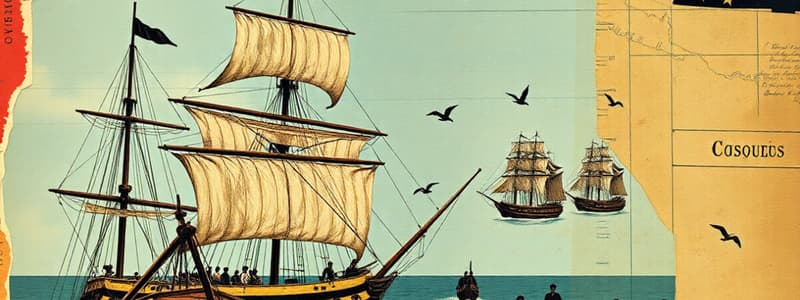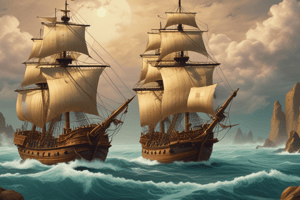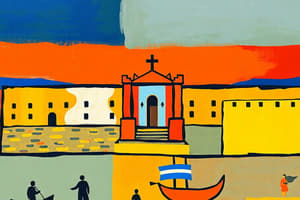Podcast
Questions and Answers
What was the primary motivation for Columbus's journey?
What was the primary motivation for Columbus's journey?
- To establish trade routes with Africa
- To discover new lands for Portugal
- To find a faster sea route to India (correct)
- To spread Christianity in Asia
Which ship was the largest among Columbus's fleet?
Which ship was the largest among Columbus's fleet?
- The Pinta
- The Niña
- The Santa Maria (correct)
- The Gibraltar
On what date did Columbus's ships leave the Canary Islands?
On what date did Columbus's ships leave the Canary Islands?
- August 3, 1492
- September 9, 1492
- September 6, 1492 (correct)
- August 6, 1492
What significant challenge did Columbus face before his expedition?
What significant challenge did Columbus face before his expedition?
Which notable explorer discovered the eastern sea route to India before Columbus?
Which notable explorer discovered the eastern sea route to India before Columbus?
How many crew members were on the Santa Maria during Columbus's voyage?
How many crew members were on the Santa Maria during Columbus's voyage?
What type of ships were the Pinta and Niña considered?
What type of ships were the Pinta and Niña considered?
What did Columbus believe about the western route to India?
What did Columbus believe about the western route to India?
Flashcards
15th Century European Beliefs about the World
15th Century European Beliefs about the World
In the 15th century, most Europeans believed the Earth was flat and only Europe, Africa, and Asia existed. This limited worldview restricted their understanding of the globe's true shape and size.
Columbus's Motivation
Columbus's Motivation
Christopher Columbus, driven by a desire to find a faster sea route to India for spices and riches, believed a western route existed.
Christopher Columbus: Early Life and Expertise
Christopher Columbus: Early Life and Expertise
Born in Genoa, Italy, Columbus learned his father's craft of weaving and spent his early years at sea. He gained expertise in navigation, meteorology, and astronomy through his experiences.
Columbus's Expedition Funding
Columbus's Expedition Funding
Signup and view all the flashcards
Columbus's Fleet
Columbus's Fleet
Signup and view all the flashcards
Cannons on Columbus's Ships
Cannons on Columbus's Ships
Signup and view all the flashcards
Departure of Columbus's Expedition
Departure of Columbus's Expedition
Signup and view all the flashcards
The Crew of Columbus's Expedition
The Crew of Columbus's Expedition
Signup and view all the flashcards
Study Notes
Spirit of Adventure
- Adventure is associated with excitement, danger, and risk, requiring preparation for a positive experience
- Early explorers sought new lands and riches, leaving known territories
- In the 15th century, Europeans believed the world was flat, with only Europe, Africa, and Asia known
- Portugal, seeking new routes to Asia, was a focal point of exploration
- Bartholomew Diaz discovered the eastern sea route to India via the Cape of Good Hope
- Christopher Columbus, an Italian navigator, believed in a western route to India
- Columbus initially sought support from Portugal and later Spain, eventually gaining consent
- Columbus's ships, Santa Maria, Pinta, and Niña, set sail from Palos, Spain on August 3, 1492
- They were equipped with cannons and provisions for a long journey
- The ships sailed for the Canary Islands to gather supplies, then ventured into the unknown Atlantic Ocean
Studying That Suits You
Use AI to generate personalized quizzes and flashcards to suit your learning preferences.




